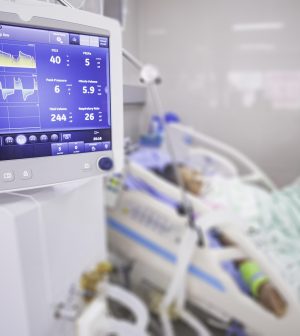- Navigating Your Midlife Crisis: Embracing New Possibilities
- City Raccoons Showing Signs of Domestication
- Mapping the Exposome: Science Broadens Focus to Environmental Disease Triggers
- One Week Less on Social Media Linked to Better Mental Health
- Your Brain Changes in Stages as You Age, Study Finds
- Some Suicide Victims Show No Typical Warning Signs, Study Finds
- ByHeart Formula Faces Lawsuits After Babies Sickened With Botulism
- Switch to Vegan Diet Could Cut Your Greenhouse Gas Emissions in Half
- Regular Bedtime Does Wonders for Blood Pressure
- Dining Alone Could Mean Worse Nutrition for Seniors
COVID Triggered More Cases of Deadly Sepsis During Pandemic Than Thought

The life-threatening infection sepsis was more common than once thought among COVID-19 patients early in the pandemic.
Massachusetts researchers linked SARS-CoV-2, the virus that causes COVID, to about 1 in 6 sepsis cases at five Boston hospitals during the pandemic’s first 2-1/2 years.
Researchers from Brigham and Women’s Hospital said their findings suggest health care workers should rethink how they treat sepsis. The use of electronic health data also provides a framework for future sepsis surveillance, they said.
“Most people, including medical professionals, equate sepsis with bacterial infections,” said lead author Dr. Claire Shappell, a specialist in pulmonology and critical care medicine. “This is reflected in treatment guidelines and quality measures that require immediate antibiotics for patients with suspected sepsis.”
But “viral infections, including the SARS-CoV-2 virus that causes COVID-19, can trigger the same dysregulated immune response that leads to organ dysfunction as in bacterial sepsis,” Shappell added in a hospital news release.
For the study, her team used health records from five Mass General Brigham hospitals to track the rate of COVID-associated sepsis. Their criteria included testing positive for COVID and clinical signs of organ dysfunction.
“Previous efforts to quantify the burden of SARS-CoV-2-associated sepsis have been limited by inconsistent definitions and under-recognition of viral sepsis,” said senior author Dr. Chanu Rhee, an associate epidemiologist at Brigham and Women’s.
“Our prior research has shown that [electronic health record-based] surveillance can provide more accurate estimates of sepsis incidence and outcomes compared to administrative datasets, but this method had not previously been applied specifically for sepsis associated with SARS-CoV-2 or other viruses,” Rhee said in the release.
Using data for March 2020 through November 2022, the researchers found more than 430,000 hospitalizations among more than 260,000 people.
About 5.4% of hospitalizations were due to COVID infections. Among those patients, 28.2% had COVID-associated sepsis.
The death rate for patients with COVID and sepsis was initially high — about 33% — in the pandemic’s first three months, the study showed. Over time, that declined and was similar to the death rate for bacterial sepsis, which is about 14.5%.
The use of electronic health data provides a framework for future research into sepsis associated with other viruses, such as influenza and respiratory syncytial virus (RSV), researchers said.
They now aim to apply this method to larger, nationally representative datasets.
“We also hope our findings highlight that sepsis is not a ‘one-size-fits-all’ entity, but one that requires clinicians to tailor their diagnosis and treatment strategy to each patient’s syndrome and probable pathogen,” Shappell said.
Findings were published Sept. 29 in JAMA Network Open.
More information
The U.S. National Library of Medicine has more on sepsis.
SOURCE: Mass General Brigham, news release, Sept. 29, 2023
Source: HealthDay
Copyright © 2025 HealthDay. All rights reserved.










